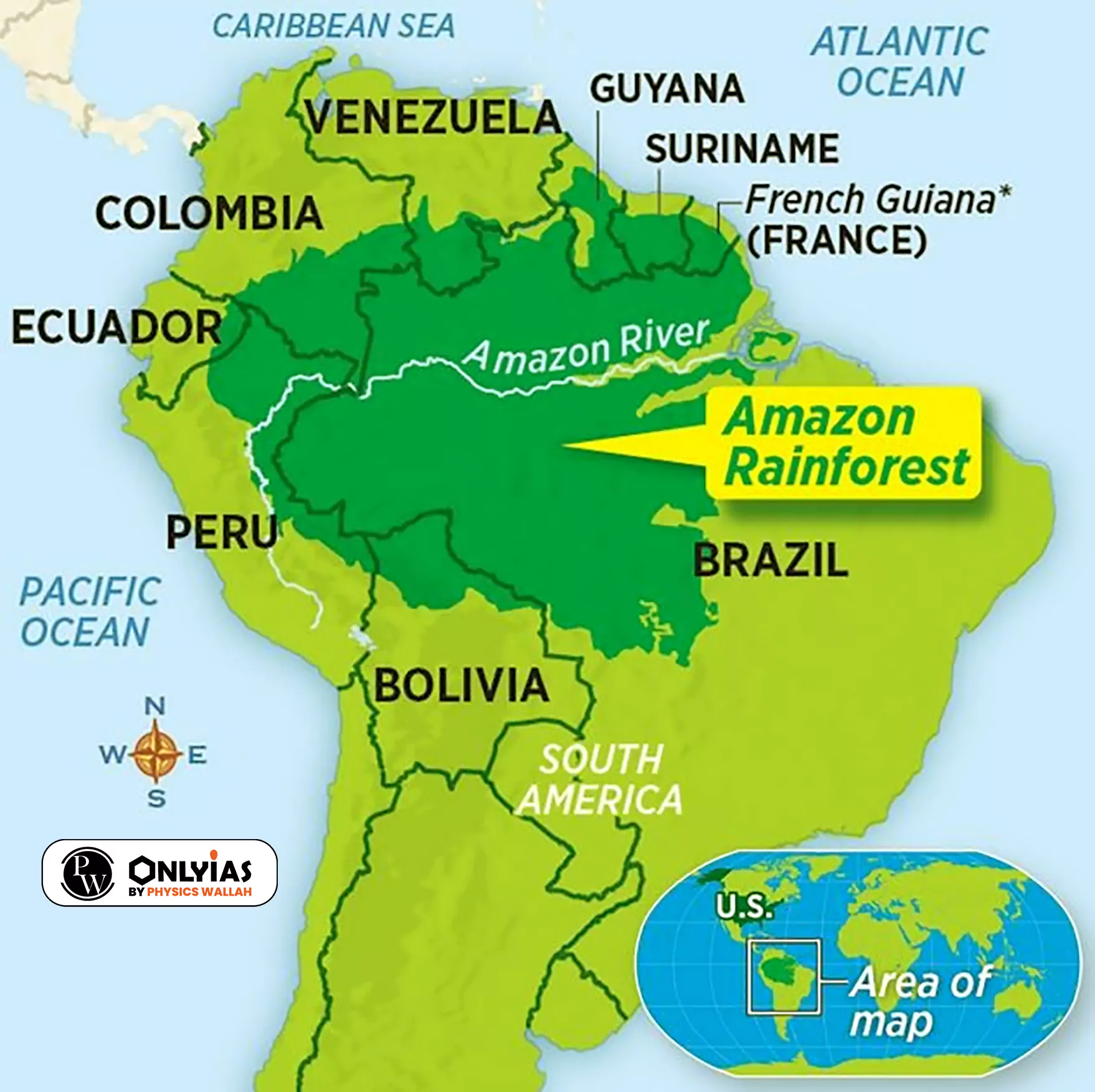Context:
- This article is based on an Editorial “Severe drought grips the Amazon rainforest: The impact, cause and grim future” which was published in the Indian Express. As per Brazilian authorities the Amazon rainforest is facing the worst drought in history.
- The latest calamity is becoming another cause for accelerating the destruction of the Amazon, called the planet’s lungs (as it stores more than 150 billion metric tonnes of carbon).
| Relevancy for Prelims: Amazon Rainforest, Drought, Forest fire, El Nino, Climate Change, Greenhouse Gases and Deforestation.
Relevancy for Mains: Amazon Rainforest, Concerns with intense drought of Amazon rainforest and measures need to be taken. |
What factors are contributing to the intense drought in the Amazon rainforest?
- As per the National Institute for Amazonian Research (INPA), the combined effect of El Nino and high sea surface temperatures have resulted in a more intense drought that also affects a larger area of the Amazon biome.
- Onset of El Nino: It refers to an abnormal warming of surface waters in the equatorial Pacific Ocean. It increases the temperature and triggers more extreme heat in many parts of the world and in the ocean.
- High Sea Surface Temperatures: Due to unusual high water temperatures in the northern tropical Atlantic Ocean, heated air rises into the atmosphere, and then reaches the Amazon rainforest, which inhibits the formation of clouds and causes rainfall to drop sharply.

Earlier Concerning Studies
- Proceedings of the National Academy of Sciences (PNAS) Studies: With rising global temperatures, the Amazon will experience longer and more frequent droughts.
- Continuation of current fossil fuel consumption rates would experience major drought nine out of every 10 years by the year 2060.
- Study published in the Journal Nature: The Amazon has become slower at recovering from longer periods of drought over the past 20 years and is nearing its tipping point.
- Beyond the tipping point, it would transform from a lush green forest into a drier open savanna, releasing a large amount of stored carbon, which would, in turn, exacerbate global warming.
|
Also Read: Forest (Conservation) Amendment Bill, 2023
Dangerous Impacts are being Observed
- Drying of Water Bodies: The Rio Negro, one of the world’s largest rivers by discharge levels, has fallen to a record low level of 13.59 metres.
- Scarcity of Basic Necessities: Numerous vital rivers have dried up, resulting in no water, food, or medicine in villages of Indigenous communities living in the area.
- Death of Marine Species & Water Contamination: High numbers of fish and river dolphins, known as boto, have been washing up dead due to low water levels.
- Also their rotting carcasses have contaminated the water supply in some areas, forcing residents to use it for cooking, bathing, and drinking.
- Impact on Hydropower Plant: The lack of water has also stalled the operations of a major hydropower dam in the region.
- Forest fires: The Amazonas state has witnessed 2,700 blazes — the highest ever noted for the month of October. The extreme dry conditions have made the rainforest more vulnerable to wildfires too.
- Environment & Health Impacts: Smoke from wildfires has rapidly decreased air quality in Manaus, a city of the Amazon, to hazardous levels.
- Children and older people living in the city are struggling to breathe and many have ended up in hospitals.

Conclusion:
In the past five decades, between 17 and 20 percent of the Amazon has been destroyed. Rainforest might appear like a distant world, but everyone on Earth is connected to its fate. Therefore, there is an urgent need to curb deforestation and greenhouse gas emissions to protect the Amazon, and, where possible, reforest the degraded regions.
| Prelims Question (2021)
“Leaf litter decomposes faster than in any other biome and as a result the soil surface is often almost bare. Apart from trees, the vegetation is largely composed of plant forms that reach up into the canopy vicariously, by climbing the trees or growing as epiphytes, rooted on the upper branches of trees.” This is the most likely description of
(a) Coniferous forest
(b) Dry deciduous forest
(c) Mangrove forest
(d) Tropical rain forest
Ans: (d) |
![]() 19 Oct 2023
19 Oct 2023



